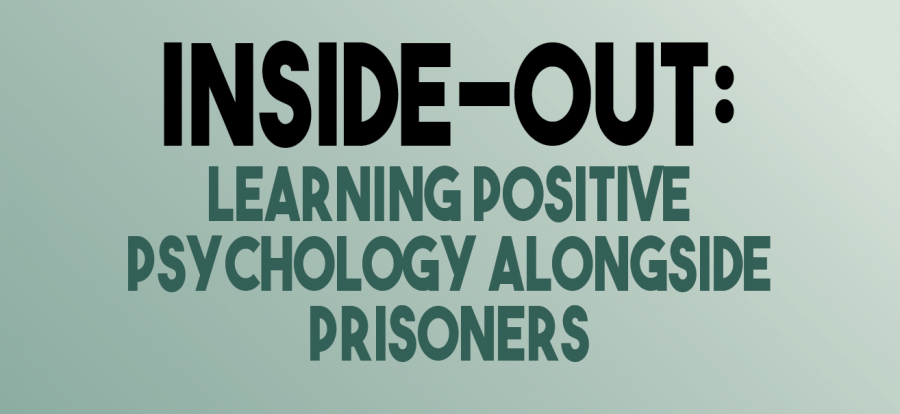Inside-Out: learning positive psychology alongside prisoners
September 26, 2019
Most of the University’s students know PSYC 242 (Positive Psychology) better as “Prison Psych.” As one of the courses offered at the University, PSYC 242 is not your typical lecture. Associate Professor of Psychology Kim Daubman facilitates the class in accordance with the Inside-Out Prison Exchange program.
Inside-Out Program
According to its website, the Inside-Out Prison Exchange Program was founded in 1997 with the aid of Lori Pompa, a professor of criminal justice at Temple University in Philadelphia. She originally took a group of students for a simple panel discussion at a prison in Dallas, Pa., and grew inspired to turn it into a semester-long program. Since then, it has flourished into an international initiative that has benefited over 38,000 students across a breadth of higher education and correctional institute partnerships.
At the University, Daubman’s Positive Psychology course is known for its unique approach. Isobel Lloyd ’21 was enrolled in the course in the spring of last year as part of her psychology and economics double major. She remarked that a common misconception about the class is that people think the University’s students are there to study the prisoners. This is not the case.
“People think we are going in to observe the prisoners, but we aren’t,” Lloyd said. “We are taking the class with them; they are our equals. When we are there, we are all just students who are expected to do the same readings, activities, and participate. And beyond being students, we are all more similar than you would think.”
How Does PSYC 242 Work?
The class meets at the State Correctional Institution (SCI) at Muncy, about a 30-minute drive from the University’s campus. In order to conduct the class at that location, Daubman transports her students on a bus every Wednesday at 12 p.m. When students first arrive, they wait in the visitor deck until the facility clears them to enter. Because the course meets at SCI Muncy, students are required to go through security clearances and have a restricted selection of items that they can bring into the space (i.e., no papers or books are allowed into or out of the facility). Therefore, with limited resources, the curriculum heavily revolves around discussions.
Despite the fact that SCI Muncy is a maximum-security prison, the beautiful stone buildings and grassy lawns are astonishingly similar to the University and other college campuses. Some inmates freely roam the facility’s grounds, creating a lively community some students say resemble a college campus. While the University’s students are only exposed to one education building at the facility, SCI Muncy does have other features of a college campus, including a public library.
Abby Tate ’22 is also a student who is currently enrolled in PSYC 242 and has visited the facility multiple times. “I was especially taken aback by the library — it reminded me a lot of the public library I have back home. I really don’t feel like I am at a maximum-security prison when I am there. Granted, I only see a small piece of it,” Tate said.
First Day of Class
Lloyd recalled that the first day her classmates and she arrived, a correctional officer facilitated the students through a security training session preceded by lots of paperwork and clearances. In the next class, the students met their classmates. For the sake of the students’ privacy inside and outside of the facility, all of the students are only referred to on a first-name basis. In addition to protecting personal privacy, this policy helps the University’s students overlook the criminal backgrounds of their peers and focus on the people in front of them.
“At the end of the class, the incarcerated students expressed their gratitude for this because it was a refreshing break from being labeled as just a number and was very humanizing,” Lloyd said. She also noted that, by five or six weeks into the course, there is a turning point in the class where everyone feels more comfortable and opens up, sparking even more connection and engagement between peers.
Future Takeaways
One of the biggest takeaways Lloyd left the class with was a more holistic perspective on life. She admits that she never would have taken a positive psychology class if the SCI Muncy aspect had not drawn her in, and she is appreciative of this different facet of psychology. This specific branch of psychology focuses on human flourishing and on applying intellectual approaches that allow people to thrive and perform at optimal functioning. Lloyd admits that she employs a lot of the skills she learned in PSYC 242, including pursuing things that may not be in her comfort zone and feeling more comfortable discussing more taboo aspects of society today. In addition, the students at the correctional institution participating in the Inside-Out Program were more enthusiastic and engaged in the class than Lloyd expected. Daubman sets the reading level at the 10th-grade level or higher, so the inside students are all more than capable of bringing meaningful insight to the table.
“They are very open to discussing things that personally I feel are stigmatized in [the University’s] culture, which brings a fresh dimension to class discussion you can’t find here on campus,” Tate said. “Even though I am only a few weeks into the course, I can already tell this is going to be one of those classes I rave about for years.”
Part of the mission statement of the Inside-Out Program is to catalyze change that has the capability to make communities more inclusive, just, humane, and socially sustainable. “I am grateful to be a part of this program and both Isobel and I definitely recommend it,” Tate said. “If you have room in your schedule, this is one of those once-in-a-lifetime experiences that is unique to [the University].”





















